Possibilities of the Akabane Test and ТСМ Principles for Monitoring Patients with Sick Sinus Syndrome
A B S T R A C T
Background: Sick sinus syndrome (SSS), in terms of diagnosis and treatment, is one of the most difficult problems associated with irregular heart rhythm. Until now, there is no unified generally accepted theory explaining its pathogenesis, there are no unambiguous criteria for making a diagnosis. In this regard, it is interesting to consider this disease from the point of view of Traditional Chinese Medicine (TCM) based on the results of assessing the bioenergetics of such patients using the Akabane test.
Methods/Design: On the basis of the cardiac surgery department of a multidisciplinary hospital, 107 patients with a verified diagnosis of SSS and receiving only medication were examined. Of these, there were 64 men and 43 women. In total, 245 tests of Akabane were carried out, including in the dynamics of observation.
Results: according to this test, with tachy and brady syndrome, as well as with normosystole, these patients showed general patterns at the level of acupuncture canals (AC), which consisted in an increase in asymmetry at the level of their left and right branches, while in the norm of this asymmetry was not. In addition, the opposite dominance of the left and right branches of the AC was revealed in tachy and brady syndrome. The analysis of these dependencies from the point of view of TCM is carried out. The possibility of predicting the time and nature of arrhythmias based on the assessment of biorhythms of certain AC is shown.
Conclusion: Alternative concepts of the pathogenesis of this disease are shown. The use of the Akabane test for patients with SSS allows them to be effectively monitored based on new physical principles, which is much easier and more convenient compared to traditional methods.
Keywords
Akabane test, monitoring of arrhythmias, tachycardia-bradycardia syndrome, heart rhythm abnormality, cosinor analysis
Introduction
The term “sick sinus syndrome”, introduced by M.J. Ferrer (1968), means the occurrence of a sharp bradycardia or cessation of the sinus node activity with paroxysms of supraventricular tachycardia. The clinical picture of this syndrome is characterized by extreme polymorphism of heart rhythm disturbances even in the same patient, which complicates the diagnosis and prognosis of the condition [1-4]. The existing methods of Holter monitoring of these patients are rather complicated and expensive. In this regard, we conducted this study, showing the capabilities of the Akabane test and its interpretations in the light of TCM for monitoring these patients.
According to the main theoretical concepts of TCM, the work of all human organs and systems is controlled by the system of Acupuncture Channels (AC), which are represented on the human body by Acupuncture points, which, based on the connection with a certain organ or physiological system, are connected into an energy line that forms a specific AC. At the same time, various types of influence on such points lead to a change in the activity of the organs associated with them, which is used in reflexology. The quantitative assessment of AC activity is especially effective using the Akabane test, which has high correlations with various physiological and biochemical parameters of the body, which allows effective monitoring using this simple test. In TCM, it is customary to assess the activity of an AC by the amount of Chi (QI) energy in it, which from the point of view of modern physiology corresponds to the concept of “Functional activity” of a certain organ or system with which a particular AC is connected.
Figure 1: The system of Five primary elements.
In turn, the 12 main AC form the system of the 5 Elements (Figure 1), which are responsible for the general balance of energy distribution in the body through stimulating and inhibiting interactions between the organs [5-7]. According to a number of researchers, in terms of its principles this five-point system of regulation is one of the most accomplished and well-known in modern technology. Traditionally, the level of energy (activity) is characterized by two notions. These are ‘fullness’, which corresponds to the hyperactivity of an organ corresponds to the YANG factor, and ‘emptiness’, which corresponds to an organ's inactivation and corresponds to the Yin factor. According to TCM, the main flow of energy moves clockwise in a circle of circulation. However, as a result of various reasons, the uniform movement of energy at the level of certain AС and primary elements can be disturbed and lead to its local excess or deficiency. In this case, other regulatory mechanisms are manifested, associated with the depressing effect of one primary element on another. For example, an excess of energy of the primary element Fire - inhibits (melts) Metal. Metal destroys Wood, and it destroys the Earth. Water slows down (extinguishes) Fire, and the Earth blocks the path of Water. The interaction of these connections is important for understanding the causes of arrhythmias.
There are a number of modern studies showing that AС are real systems for transferring information between the environment and living organisms, including plants. Wherever there is water, information transmission channels are spontaneously formed where there is a dynamic self-focused propagation of coherent radiation with its phase synchronization [8-11]. Such energy waves in the connective tissue can ‘capture’ neighbouring molecules, cells and biological units in their coherent vibrations. Thus, this optical waveguide in the form of an AС can provide a nondissipative flow of energy and information throughout the body [12]. It was found that the main electrophysiological and echocardiographic indicators of the heart function have significant correlations with the AС activity according to the Akabane test [13]. Thus, this test can be used to effectively monitor cardiac patients.
Materials and Methods
In total, 107 patients with a verified diagnosis of SSS, who received only drug treatment, were examined on the basis of the cardiac surgery department of the 26 St. Petersburg multidisciplinary hospital. Of these, there were 64 men and 43 women. In total, they performed 245 Akabane tests, including those in the dynamics of observation at different heart rate values. To quantitatively evaluate a channel's activity level in TCM, the so-called “sacrificial stick” test was used in ancient times in China. This test involved a burning sandal stick that was brought in proximity to points at the tips of every finger and toe until the first sensation of pain. At each point, the pulse rate before pain was first felt, was measured. If the number of pulse beats was lower than the average one for all the channels, it proved the hyperactivity of an acupuncture channel and its corresponding organ. Conversely, when the rate was higher, it represented the inactivity of a channel and its corresponding organ.
Figure 2: Topography of acupuncture points, used for evaluation of the AC in Akabane test.
This test was described by the Japanese doctor Koben Akabane in 1956. Since then, the test has carried his name [14]. This test measures the pain thresholds in temperature sensitivity (TS) when heat is applied to the “entrance-exit” points of each channel (LU11, LII1, PC9, TE1, HT9, SI1, SP1, LR1, ST45, GB44, KI1, and BL67) by applying an impulse light-emitting diode (LED) non-coherent infrared radiation (IR)-light onto the skin (f = 1 Hz, λ = 920 nM), recording the total energy expenditure in joules [15-17]. Each impulse radiates 0.07 joules of thermal energy. These measurements were carried out using a certified device- ‘Merid’, invented by the author of the paper. TS is our bodies’ basic reactive system; it is as significant as important indicators such as body temperature, as it gives a very clear representation of functional and psycho-physiological profiles. Their topography is shown in (Figure 2).
According to classical Oriental literature as well as according to our study results, the following channels have different regulatory functions:
LU - lungs channel, connected with the function of lungs and tissue breathing.
Li - large intestine channel, connected with the large intestine function and its microbe flora, it participates in the regulation of arterial pressure, biochemical blood indices.
PC - pericardium channel, connected with the cardiac muscle trophicity and its structure. In addition, it is connected to muscular activity, arterial blood pressure levels and emotions.
TE - triple heater channel, connected to the central and peripheral hemodynamic, and with body energy consumption. In addition, it regulates the hormones in the body, thyroid and hypophysis.
HT - heart channel, regulates the cardiac rhythm, body’s physical strength.
Si - small intestine channel, connected to the electrolytic balance and food digestion.
SP - spleen-pancreas channel is connected to the pancreas and immunity.
LR - liver channel is connected to liver function and central nervous system, stress levels
St - stomach channel is connected to the digestion function.
GB - channel of the gallbladder is connected to the digestion function and peripheral nervous system.
Ki - kidney channel is connected to the kidney function and the adrenal glands.
BL - urinary bladder channel is connected to the urogenital system, its functions and its related hormones, it reflects the state of vertebrae column as well [15-20].
Each channel consists of the left (l) and the right (r) branch between which normal symmetrical activity balance is maintained.
To evaluate the parameters of the biorhythmic activity of organs and body systems, the Cosinor analysis method is currently widely used, when using the smallest standard deviations from points with real measurements of АС parameters in the dynamics of observation, we can construct a resulting curve reflecting the biorhythm [21, 22]. To calculate the biorhythm parameters, we used the licensed TSA programme (Time Series Analysis-Cosinor V-6.0 Lab View. License N 125403071), as well as analogues of this programme. Statistical decisions were made at a significance level of 5% (р≤0.05). Data analysis was provided using software package SPSS Inc. V 15.
Results
Since the general thresholds of perception of temperature pain sensitivity have individual differences, in order to compare the HR parameters between different patients, the ratio of each indicator to the arithmetic mean of 24 values of this test was found. So, after scaling, the weighted average TS was close to 1.0. In the case of functional insufficiency (Yin syndrome) of the associated physiological system or organ, this indicator was more than one, and with its increased activity (Yang syndrome) it became less than 1.0 in proportion to the degree of its severity. At the time of the test, in 63 cases, there was a brady syndrome when the heart rate was less than 60 beats/min. Normosystole (heart rate = 60-80 beats/min.) Was noted in 146 cases, and tachycardia syndrome in 46 cases, when the heart rate exceeded 80 beats/min. We studied the main relationships between heart rate and the state of AC from the position of these three groups.
Figure 3: Diagram of the distribution of AС activity in tachycardia, bradycardia and norm systole.
Figure 3 shows the averaged graph of the Kiwiata diagram of the distribution of HR parameters for 12 main AС at the time of tachycardia, normo-systole and at the time of bradycardia with a heart rate of less than 50 beats/min. With the norm of systole, the indicators of all AС are more balanced and there is no significant asymmetry between the right and left branches of the AС, and the maximum mean values of the BL channel indicator are 1.96. In tachycardia, the minimum AC values of the primary element ‘Fire’ (PC, TE, HT, SI) and the maximum values (3.75) of the BL channel are noted. At the same time, a significant asymmetry is observed between the right and left branches of the BL, KI, BL channels. With bradycardia, there is less hyperactivity of AС ‘Fire’ and less AС ‘Water’ (BL = 2.55), but with a greater level of asymmetry, especially along the BL channel, which controls the peripheral nervous system. With all this, the most important difference between tachy and brady syndrome is the change in laterality, especially along the BL channel. So, with tachycardia, its Yang-left branch (BLl) dominates, and with bradycardia, the right (Yin) branch (BLr) already dominates. A similar situation was noted in the difference in AC laterality- GB and KI.
These data show the importance of evaluating symmetry - desymmetry in the body at the AС level as the main criterion for the manifestation of pathology in the body. The higher the level of asymmetry in the AС, the higher the level of functional or organic changes in organs or physiological systems associated with a specific AС [15-17, 19, 20]. Since changes in symmetry in the AС precede the clinical manifestations of crisis states, thus, already by visual assessment of the AС profile, especially in the dynamics of observation, thus it is possible to predict tachy or brady arrhythmias based on the ratio of the right and left branches of the indicated AС.
According to our observations, in tachy and brady syndrome, with an increase in heart rate deviations from the norm, the asymmetry most reliably increases not only mainly along the BL channel, but also between the right and left branches of LU, LI, which in this pathology are a kind of trigger points in reflecting the tendency of heart rate change. An indicative template for assessing arrhythmia in SSS is shown in (Figure 4). It has a comfort zone with a number of contractions of 66 beats per minute (“Golden section of the rhythm”), corresponding to the absence of asymmetry along the channels - LU, LI, GB. Thus, there is a kind of intersection of changes in their meanings. In general, with the growth of tachycardia, the indicators of their left branches increase, and the values of the right branches decrease. With brady syndrome, the opposite relationship is observed. At the same time, with tachy syndrome, the value of the left branch of the AC-KIr and the average total values TS of the channels of the primary elements of ‘Fire’ decrease.
Figure 4: Graph of changes in AC activity depending on heart rate.
Vertical axis is the scaled channels TS. Horizontal axis- heart rate values.
According to our observations, in tachy and brady syndrome, with an increase in heart rate deviations from the norm, the asymmetry most reliably increases not only mainly along the BL channel, but also between the right and left branches of LU, LI, which in this pathology are a kind of trigger points in reflecting the tendency of heart rate change. An indicative template for assessing arrhythmia in SSS is shown in (Figure 4). It has a comfort zone with a number of contractions of 66 beats per minute (“Golden section of the rhythm”), corresponding to the absence of asymmetry along the channels - LU, LI, GB. Thus, there is a kind of intersection of changes in their meanings. In general, with the growth of tachycardia, the indicators of their left branches increase, and the values of the right branches decrease. With brady syndrome, the opposite relationship is observed. At the same time, with tachy syndrome, the value of the left branch of the AC-KIr and the average total values TS of the channels of the primary elements of ‘Fire’ decrease.
To monitor the patient's current state and predict crises, it is important to analyse each test, especially in the dynamics of observation, taking into account the obtained patterns. Along with the assessment of the quantitative relationships of the AC indicators with the heart rate, the assessment of the structure of the correlation dependences between the AC is of great diagnostic value. Since the estimation of the table correlation matrix of 24 х 24 AС is difficult for perception, we used a visual system for estimating correlation relationships based on a circular diagram. For this, two (based on the presence of + and - correlations) circular diagrams were used, taking into account the location of each AС in the structure of the five primary elements and their relationships with other AС.
Figure 5: The matrix of interchannel connections in norm.
Referring to (Figure 5) shows the matrix 24 of correlation interchannel connections characteristic in the norm of 68 carefully selected in the group of ‘healthy’ individuals (men and women) from the first sample. The relationship diagram has a pronounced polar structure in which negative connections go mainly from BL, and positive connections are present between the AK of the cardiovascular system. The thickness of the lines of the relationship diagram increases with the increase in the correlation coefficient. If we overlap the left and right diagrams, we will get one circle with two poles of interchannel positive and negative links, which completely repeats the ancient Chinese monad Yin-Yang, but at the ‘water’ and ‘fire’ primary elements’ level.
In this way the diagrams reflect the global dipole regulation structure, which forms the basis of the 5 primary elements system functioning. We discovered this energy dipole in 1995 [7, 15, 16, 23]. Normally the negative regulating pole (-) is in the ‘water’ primary element system, mostly at the urinary bladder channels level. In these channels, according to TCM, there is an accumulation of energy. The positive regulating pole (+) is mostly concentrated at the ‘fire’ primary element channel’s level, and partly at the ‘wood’ and ‘earth’ primary element channel’s level, where mainly energy consumption occurs.
Since the activity of AС is determined by the number of open points on it, then using the acupuncture atlases of TCM with the localization of points on the channels, it is easy to calculate the maximum possible theoretical activity of the (+) Yang pole, which is equal to the sum of points on the fire channels (HT+SI+PC+TE= 56 points) and the negative Yin pole (KI+BL= 94 points) [18]. Their ratio is in the proportion (1.6), close to 1.62 which is the proportion of the “Golden section”. We regard the presence of such a balance in the Dipole as a state of harmony in the body to which we must strive. With age or with illnesses, or from external influences, some of the points on the channel can ‘close’ with a change in its activity in the test. In this case, the proportion of the cross section also changes, which leads to an increase in the Yang or Yin components with loss of harmony in the dipole.
An important role in the balancing of the dipole belongs to the channels of the “boundary layer” at the level of the primary elements, tree-earth or wood-metal (АС-LR, GB, SP and LI). This line is the most dynamic by changes “boundary layer”, at the level of which, due to the transition of its separate channels into the zone of (+) or (-) regulation, the operative control of various functions of the organism takes place. As the dipole embodies the law of the “opposites unity and struggle”, the main conflicts of different kinds of pathology geneses are also located at this level of dipole regulation. Examination of different patients shows that depending on the kind of pathology or the character of the regulating influence, in which the dipole takes part, the dipole central axis can move at the primary elements level, but mostly within the borders of the ‘water’ and ‘fire’ primary elements. The number, direction and strength of connections in SSS can vary depending on heart rate with an increase in the (+) or (–) dipole component, but in general, these 24 connections reflect the individual characteristics, ‘portrait’ of each patient. Thus, the primary diagnosis of diseases is possible on the basis of the ‘fingerprint’ principle.
For the SSS syndrome itself as a whole, in addition to a violation of the structure of correlations, an increase in the influence of regulatory zones with channels - BL, PC, LI and GB, which are a kind of core of the main manifestations of this pathology (Figure 6). The role of the LI channel is explained by the influence of microbial bio flora on endogenous biorhythms of the whole organism. The state of the PC channel mainly reflects the violation of trophic disorders of the heart muscle, especially in myocarditis and ischaemia. The more active and pronounced myocardial damage, the greater the asymmetry of its branches [15, 16]. The number 24-AC itself belongs to the Fibonacci series in which all the values of the indicators are interconnected in the form of a single ensemble. 1 indicator changes- in response to this, the values of all others change, as in a kaleidoscope. Therefore, for example, using discriminant analysis according to the data of several tests and training groups, it is possible to diagnose various rhythm disturbances with an accuracy of more than 80% [15].
Figure 6: The matrix of correlations between the AC with SSS.
To understand the influence of specific AС on various indicators in various diseases, the use of the stepwise regression method is especially effective [15-17, 19, 20, 24, 25]. However, in this case, especially according to the data of group statistics, the results are rather blurred, since at different frequency ranges of the pulse in the obtained models, the sides of the AС and the signs of influence change. The influence is also exerted by the different genesis of this disease. Table 1 shows the final step-by-step linear regression model of the relationships between AС and heart rate in 43 men with SSS at the time of tachycardia.
Table 1: Final step-by-step linear regression model of the relationships between AС and heart rate in men with SSS.
|
Channels |
b |
SE |
t |
p |
|
Constant |
68.31 |
5.39 |
8.61 |
0.001 |
|
LIr |
-3.50 |
1.84 |
-1.89 |
0.06 |
|
LIl |
+3.17 |
2.00 |
1.58 |
0.12 |
|
GBl |
+2.44 |
1.65 |
2.08 |
0.04 |
|
KIr |
-3.45 |
2.31 |
-1.49 |
0.14 |
|
KIl |
+2.82 |
1.72 |
1.64 |
0.10 |
R-SQ. (ADJ.)= 0.31; 43 observations.
In this model, a fairly high coefficient of explainable variance (R-SQ = 0.3180) of the polygon of values is obtained. From the obtained dependences, only AC-GBl has a significant relationship with heart rate with a (+) sign. This means that an increase in its values will characterize an increase in tachycardia. For the LIr channel, only a tendency (p=0.06) to a significant regulatory effect on heart rate with a (-) sign was noted. This means that an increase in its indicator will be accompanied by a decrease in heart rate. An interesting situation is noted for AC-LI and KI. Their right and left branches have different vectors of influence on heart rate. This situation at the level of individual AС is typical for understanding the principle of their regulatory influences [15-17, 19, 20]. In general, such a regulatory model can be represented in the form of 2 scales, on one side of which there are АС with an influence sign (+), and on the other with (-). Substituting into such a model the specific values of the test indicators for the AС according to the balance of total weight values, one can roughly calculate the heart rate value at the moment.
This assessment technique is especially relevant when building individual models. Table 2 presents a regression model of the relationship between AС and heart rate of one of the patient (C ... ..c), age 52 years. Suffering from tachy brady form of SSS for about 2 years on the background of sluggish current hepatitis. She independently performed 28 tests for himself.
Table 2: Step-by-step individual regression model of the relationship between channels and heart rate variability.
|
Channels |
b |
SE |
t |
p |
|
Constant |
78.83 |
8.49 |
9.28 |
0.001 |
|
LIr |
-9.73 |
3.02 |
-3.21 |
0.009 |
|
TEr |
-22.61 |
6.59 |
-3.24 |
0.006 |
|
GBl |
43.54 |
10.37 |
4.19 |
0.001 |
|
SPl |
12.24 |
3.24 |
3.76 |
0.003 |
|
LRl |
-11.13 |
4.74 |
-2.34 |
0.040 |
|
BLr |
-7.36 |
1.47 |
-4.99 |
0.001 |
R-SQ. (ADJ.)= 0.78; 28 observations.
In this model, the activity of the liver and spleen AС has a significant effect on heart rate, which is associated with the involvement of the immune system in the process against the background of hepatitis. In general, the GBl channel has the greatest influence on HR in terms of coefficient and significance. The higher the values of its indicators, the higher the heart rate will be. A negative feedback relationship with an increase in heart rate is reflected by the BLr channel. The higher its values are, the lower the heart rate will be. According to our observations, these changes in the heart rate usually occur 20-30 minutes before real changes in the heart rate, which allows us to carry out their prognosis and preventive measures, for example, by influencing reflexotherapy methods on certain channels.
Figure 7: Graphs of amplitudes and periods of 4 AC according to Cosinor analysis data.
Along the vertical axis- the amplitude of oscillations, along the horizontal axis - the periods of oscillations in hours.
In general, the AС is characterized by wave-like pulsation in time due to the influence of endogenous biorhythms, the parameters of which can be estimated using the Cosinor analysis [21, 22]. On the obtained rhythmograms of this patient (Figure 7), fluctuations in GBl channel values have a period of 12 hours, BLr - 13 hours, SPl -8, and TEr - 46 hours. If we look at these biorhythms in time, then due to the interference of their amplitudes and periods, situations arise when the total positive or negative components of the influence of certain AС on the heart rate suddenly prevail, which explains the appearance of tachy or brady syndrome according to an individual regulation model. Since these biorhythms obtained on the basis of a set of measurements can be extrapolated to the future, it becomes possible to predict crisis situations. The technique of such calculations based on Cosinor analysis was described earlier [26]. On the other hand, a targeted influence on these AС in the function of the obtained dependences allows you to change the phase and period of those channels that have the greatest component of influence on the formation of tachy and brady syndrome. Thus, you can get a scientifically based protective and therapeutic effect. In addition, if you synchronize the intake of various drugs with the biorhythm of certain AС on the principles of chrono pharmacology, you can get an additional effect even with a significant reduction in their dose.
Discussion
Taking into account the test profiles for rhythm disturbances in (Figure 2), one can recognize the importance of evaluating symmetry- desymmetry in the body at the level of the branches of the AK as a marker of the formation of pathology. In inanimate nature, for example, at the level of crystals, there is absolute symmetry. All living things are characterized by slight asymmetry. This was written in China back in the ancient “Book of Changes”, where the transition from non-living to living was first modeled and traced at the level of evolution of hexograms. However, the question of the permissible degree of desymmetry and its relationship with the norm and pathology in the body remains open. In previous studies, we tried to develop criteria for assessing the degree of asymmetry at the level of human organs and systems based on the proportions of the “Golden Ratios” and thus, using this universal criterion of harmony, to separate the norm from the pathology [7, 15, 16, 19, 20]. Since the AС have right and left branches, through them, for the first time, a unique by the very principle, the opportunity to assess the level of asymmetry at the level of certain organs and physiological systems according to this test is presented. The level of such violations of asymmetry is not yet possible to assess in any other simple way, especially for their easy monitoring.
Figure 8: A model of arrhythmia formation at the level of the “Five primary elements”.
Next, we will consider 2 main scenarios of arrhythmias from the TCM point of view. The first option is somatic. It provides for the presence of significant organic or functional disorders in some organs and systems, which is reflected in the diagnosis at the level of their AC. As shown by the results of correlation and regression analysis, in almost all group and individual models, the colon canal has a role in the regulation of heart rate in SSS. How can this be explained? Billions of bacteria live in the intestines, which are specific sensors that react with their community to changes in the weather, temperature outside, flashes in the sun, food ration, etc. [15, 16]. Together, they form their own biofield, which is reflected in the activity of the AC -LI. In a circle of energy circulation at the level of five primary elements (Figure 8), this information in the form of an increase or decrease in dough indicators at the level of its branches is transmitted to the BL channel, which controls the activity of all other AC (Figure 5) Through the relationship fanning from negative (Yin) dipole poles. At the same time, the growth of water energy indicators normally strengthens the potential of the Tree and restrains the potential of Fire. On the contrary, low (Yang) indicators of AC Water characterize its lack, which leads to drought of the Wood, which burns well. And the energy of Water is not enough to extinguish the Fire. This is what the classical TCM theory says.
According to our observations in relation to SSS, the predominant laterality of the right or left branch of AC-BL against the background of its pronounced hypoactivity, as well as especially the LI and GB channels, is of decisive importance in the formation of the tachy or brady syndrome (Figure 2). Therefore, the decisive importance is not the amount of energy itself, but the violation of the quality of its control at the level of the left and right branches of these ACs with a large level of asymmetry between them.
Another variant of the formation of arrhythmias is possible, for example, associated with active myocarditis or hepatitis. In this case, an increase in asymmetry between the branches of their canals (PC, SP and LR) can be a marker of pathology for these organs, especially in the dynamics of observation.
Figure 9: Model of psycho-somatic influences at the level of “Five primary elements”.
The second option is psycho-somatic. According to the proverb from TCM; “Longing hurts the lungs, fear hurts the kidneys, and malice hurts the gallbladder and liver”. To this we must add also excessive joy, which is reflected according to our observations on the PC in the form of asymmetry of its branches (Figure 9) According to TCM - excessive reflections, indecision, self-isolation affects SP and ST. However, in practice, this is difficult to notice on the test. According to our observations, we note that in many patients, especially with tachycardia, the frequency of attacks before surgery decreases, because ‘Fear’ alters the activity of the kidney canal and the associated BL. Their indicators decrease and thus Water inhibits the activity of the channels of Fire and excess energy does not splash out in the form of tachycardia attacks. As is known from the literature, the heart is laid long before the growth of nerve fibers to it [27, 28].
Therefore, the heart rhythm is primary, and the nervous influences are secondary, since nerve fibers grow into the heart only at the border of 1 and 2 months of intrauterine life. It was found that in embryogenesis “the effect of one structure on another is never one-sided, but, on the contrary, always has the character of mutual induction” [29]. So, the rhythm of the heart in a special way, for example, gives rise to the brain and its architecture. Thus, the heart, through the rhythm of contractions and information embedded in the rhythm, becomes a kind of conductor and architect in the construction of the entire structural ensemble of the body. Until now, no specific mechanism has been found by which, for example, the central and peripheral nervous systems could regulate the amount of blood flow, its speed, sort blood elements by age, the amount of oxygen in them, and transport all this to its intended purpose. Moreover, it has been proven that regional blood flow occurs without the participation of the nervous system [30].
In other studies, it was shown that in the heart with each systole at the level of the Tabesia vessels, a vortex of blood is formed, which enters certain parts of the body strictly according to its intended purpose [31]. Therefore, for example, in the uterine artery of pregnant women, the concentration of oxygen in the blood significantly exceeds its concentration in the aorta, which looks rather paradoxical! However, for such an accurate alignment and formation of the target erythrocyte twist flow, each systole is needed, in modern terms, “significant computing power”, which are clearly absent in the structure of the sinus node and the AV-junction. Such filigree work is clearly controlled by some other mechanism. Apparently, hemodynamics is also controlled by the primary embryonic and, probably, the most ancient regulatory mechanism in phylogenesis, which appeared long before the nervous system and humoral influences. It is believed that a structure of such a high level of complexity as a person could not exist without partial synchronization of all his cells and organs in the resonant mode of their interaction. The role of the synchronizing factor may come from the biological coherent fields of the AС [32].
As early as 1915, G. Driesch carried out experiments with the transplantation of embryonic cells from the embryo of a chicken eye to other parts of the body [33]. He found that the eye does not develop there! On the basis of these observations, he formulated one of the most important laws of embryology, according to which “the fate of a part of the embryo is a function of its position in the space of the embryo.” Already at the same time, a number of researchers considered the embryo as a kind of geometrical region with certain coordinate axes, inside which a biofield acts, which is individually vectorized in a certain way and species-specific and serves to synchronize the function of nearby cells [34].
The basis for such a bioenergetic framework and coordinate axes in the body, in our opinion, can be precisely the AС, from which the regulatory influence on individual organs comes through its cells, which are in the field of its action by the AС [15, 16]. In this case, the conducting system of the heart, consisting of p-cells, is precisely the morphological representative of the АС heart (HT), which has a certain topography, but can also change it. For example, in the case of reciprocal tachycardia, additional pathways arise that can be replaced by new ones after their operative destruction. The reason for this is the excess energy in the AС ‘Fire’. It is this excess energy that is periodically discharged in the form of attacks of tachycardia, and to implement this discharge, additional pathways are formed.
In this connection, a rather funny story comes to mind. I tested a patient with WPW syndrome several times. There was a persistent hyperactivity of AС ‘Fire’ with frequent attacks of tachycardia. Before the operation itself, he developed severe enteritis for no apparent reason and all attacks disappeared. At the same time, according to the test against the background of enteritis, the indicators of AС “Fire” returned to normal! Thus, the excess Yan of Fire energy was released through the small intestine. After that, the patient refused the operation, because “I understood how to effectively treat my WPW syndrome.” In the Middle Ages, tachycardia was also treated with laxatives.
At one time we were interested in the question- what will happen to the activity of the AС, for example, the gallbladder (GВ) or the stomach (ST) after their removal? On the next day, the indicators of these AC increased tenfold, which corresponded to their pronounced hypofunction and “emptiness of energy.” After 3 days, they exceeded the norm by 2-3 times, and after a month, they completely recovered. This means that the AC exists without its organ. A similar situation is observed, for example, after amputation of a leg with phantom pains or other persistent sensations in certain parts of it.
The very operation of destruction of the pathways is essentially an electric shock in the heart region, which triggers stress mechanisms with the activation of the adrenal glands, which are included in the kidney AC (KI). According to the test, this is accompanied by hyperactivity of the AC of the primary element ‘Water’. It begins to effectively suppress the primary element ‘Fire’ and the tachycardia goes away for a while.
In general, it seems that the truth in the correct treatment by the method of destruction is not entirely adequate to the mechanism of occurrence of tachy and brady syndrome from the point of view of TCM. We need to look for new principles of treatment. For such treatment of arrhythmias at the level of bioenergy and AC, a number of devices in the form of a clip on the auricle have been developed that work in a feedback function. If the pulse goes beyond a certain corridor, then there is an effect of IR -radiation on certain points of the auricle based on individual mathematical models [35].
Conclusion
Over its centuries-old history, ТСМ has accumulated vast experience in treating a wide variety of diseases, including heart rhythm disorders. A beautiful slender theory was created that has stood the test of time. Using the example of assessing the state with SSS according to the Akabane test using mathematical analysis, we tried to show its capabilities. Thus, we tried to build a conceptual bridge between Eastern and Western medicine, which undoubtedly opens up new possibilities in the diagnosis and treatment of this complex pathology.
Abbreviation
AC: Acupuncture Channels
TCM: Traditional Chinese Medicine
SSS: Sick Sinus Syndrome
HR: Heart Rate
TS: The pain thresholds in Temperature Sensitivity
Conflicts of Interest
None.
Article Info
Article Type
Research ArticlePublication history
Received: Fri 13, Nov 2020Accepted: Fri 27, Nov 2020
Published: Mon 07, Dec 2020
Copyright
© 2023 Valery Muzhikov. This is an open-access article distributed under the terms of the Creative Commons Attribution License, which permits unrestricted use, distribution, and reproduction in any medium, provided the original author and source are credited. Hosting by Science Repository.DOI: 10.31487/j.JICOA.2020.06.03
Author Info
Valery Muzhikov Ruslan Muzhikov
Corresponding Author
Valery MuzhikovCEO of the Medical Department, Med Byte Ltd., 195220, St. Petersburg, Russia
Figures & Tables
Table 1: Final step-by-step linear regression model of the relationships between AС and heart rate in men with SSS.
|
Channels |
b |
SE |
t |
p |
|
Constant |
68.31 |
5.39 |
8.61 |
0.001 |
|
LIr |
-3.50 |
1.84 |
-1.89 |
0.06 |
|
LIl |
+3.17 |
2.00 |
1.58 |
0.12 |
|
GBl |
+2.44 |
1.65 |
2.08 |
0.04 |
|
KIr |
-3.45 |
2.31 |
-1.49 |
0.14 |
|
KIl |
+2.82 |
1.72 |
1.64 |
0.10 |
R-SQ. (ADJ.)= 0.31; 43 observations.
Table 2: Step-by-step individual regression model of the relationship between channels and heart rate variability.
|
Channels |
b |
SE |
t |
p |
|
Constant |
78.83 |
8.49 |
9.28 |
0.001 |
|
LIr |
-9.73 |
3.02 |
-3.21 |
0.009 |
|
TEr |
-22.61 |
6.59 |
-3.24 |
0.006 |
|
GBl |
43.54 |
10.37 |
4.19 |
0.001 |
|
SPl |
12.24 |
3.24 |
3.76 |
0.003 |
|
LRl |
-11.13 |
4.74 |
-2.34 |
0.040 |
|
BLr |
-7.36 |
1.47 |
-4.99 |
0.001 |
R-SQ. (ADJ.)= 0.78; 28 observations.
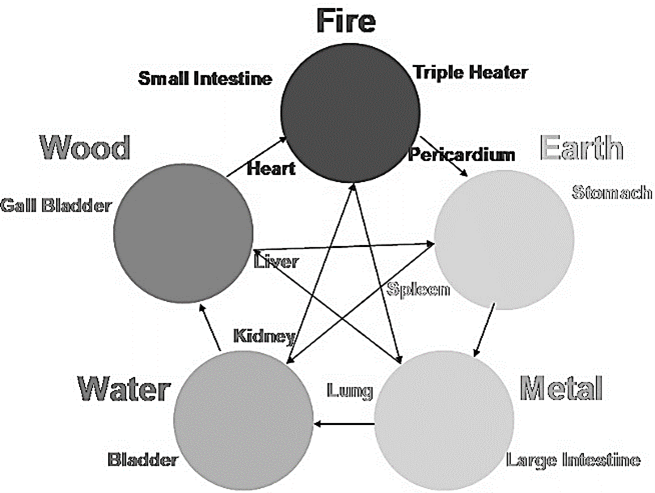
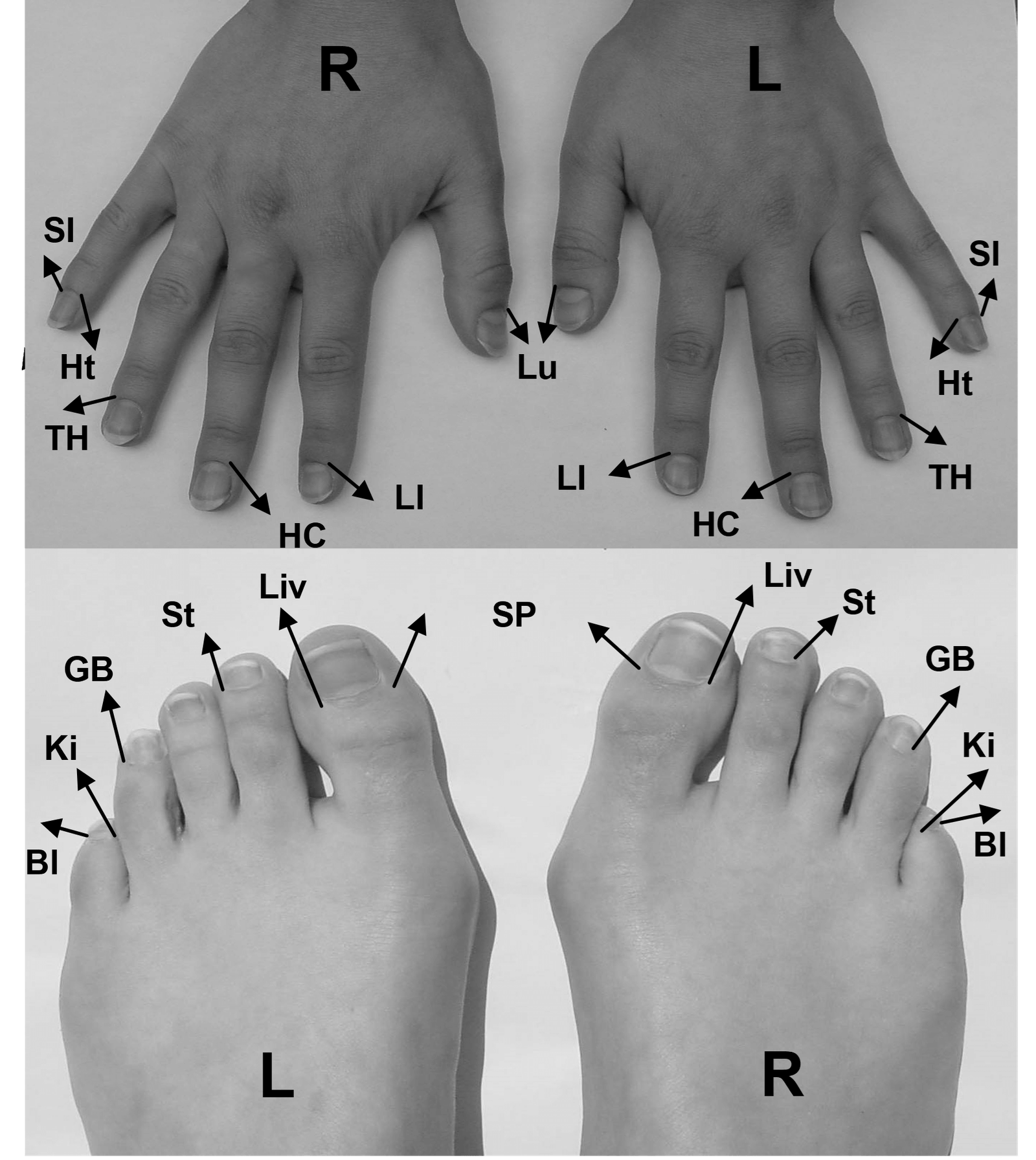
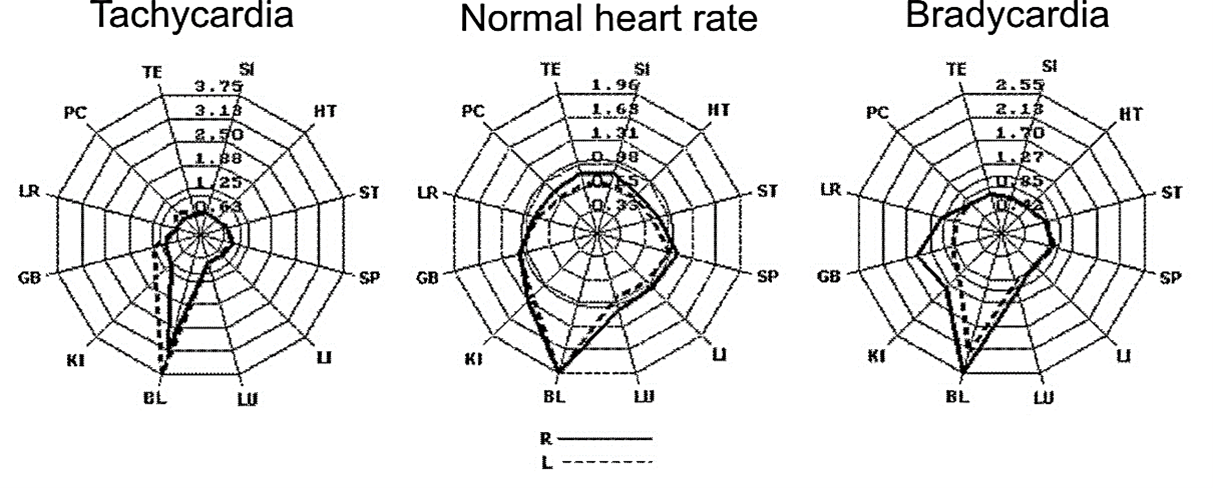
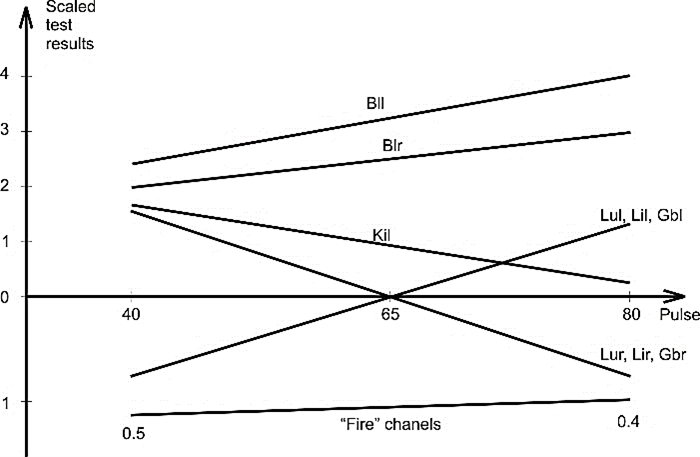
Vertical axis is the scaled channels TS. Horizontal axis- heart rate values.
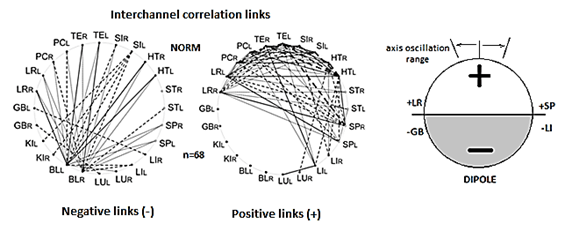
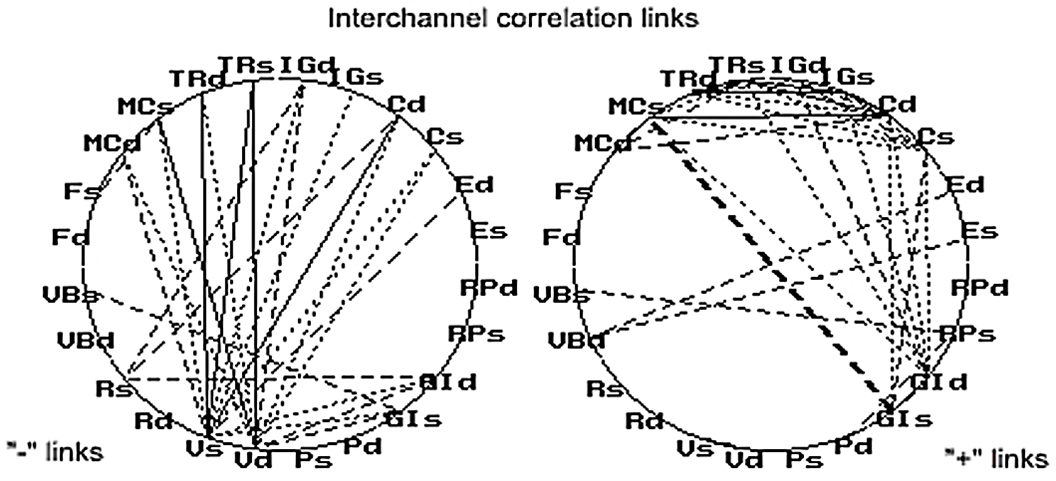
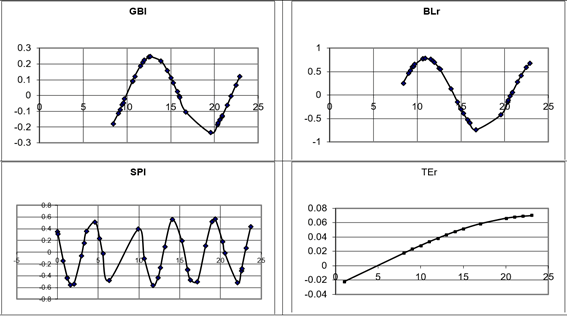
Along the vertical axis- the amplitude of oscillations, along the horizontal axis - the periods of oscillations in hours.
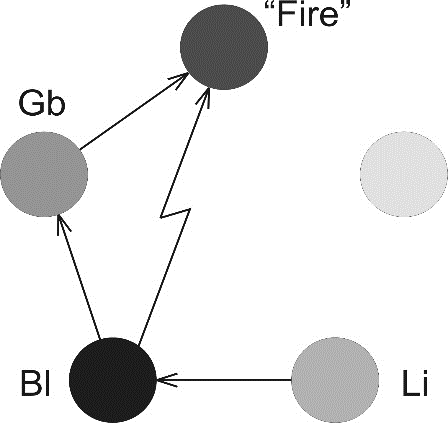
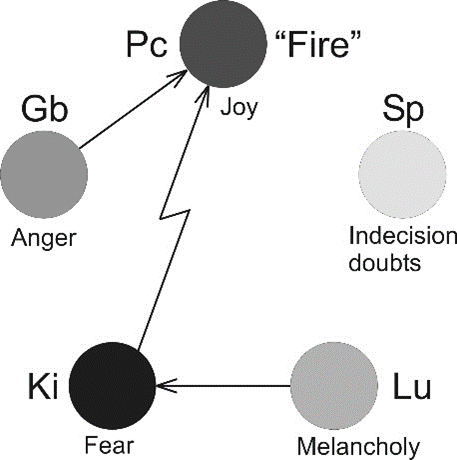
References
- Semelka M, Gera J, Usman S (2013) Sick sinus syndrome: a review. Am Fam Physician 87: 691-696. [Crossref]
- Dobrzynski H, Boyett MR, Anderson RH (2007) New insights into pacemaker activity: promoting understanding of sick sinus syndrome. Circulation 115: 1921-1932. [Crossref]
- Mangrum JM, DiMarco JP (2000) The evaluation and management of bradycardia. N Engl J Med 342: 703-709. [Crossref]
- Adán V, Crown LA (2003) Diagnosis and treatment of sick sinus syndrome. Am Fam Physician 67: 1725-1732. [Crossref]
- Ahn C, Choi D (1986) Theoretical Study on Five Element Acupuncture, Dongguk University at Kyong-Ju. Dongguk J 5: 287-309.
- Ahn CB, Jang KJ, Yoon HM, Kim CH, Min YK et al. (2010) Sa-Ahm Five Element acupuncture. J Acupunct Meridian Stud 3: 203-213. [Crossref]
- Muzhikov V, Vershinina E, Muzhikov R, Nikitin K (2018) Structure of Interchannel and Five Primary Elements Connections According to the Test of Akabane. Int J Chin Med 2: 18-29.
- Umezawa H (1993) Advanced Field Theory: Micro, Macro, and Thermal Physics. AIP, New York.
- Blasone M, Jizba P, Vitiello G (2011) Quantum Field Theory and its Macroscopic Manifestations. Imperial College Press, London.
- Del Giudice E, De Ninno A, Fleischmann M, Mengoli G (2006) Coherent quantum electrodynamics in matter. Electromagn Biol Med 25: 522-530.
- Del Giudice E, Preparata G, Vitiello G (1988) Water as a free electric dipole laser. Phys Rev Lett 61: 1085-1088. [Crossref]
- Brizhik L (2015) Influence of electromagnetic field on soliton mediated charge transport in biological systems. Electromagn Biol Med 34: 123-132. [Crossref]
- Muzhikov V, Vershinina E, Belenky V, Muzhikov R (2017) Comparative Assessment of the Heart’s Functioning by Using the Akabane Test and Classical Methods of Instrumental Examination. J Acupunct Meridian Stud 10: 171-179. [Crossref]
- Akabane K (1956) Method Oi Hinaishin. Tokyo.
- Muzhikov VG (2000) Theory and practice of the thermal acupuncture channel diagnostics and treatment. St. Petersburg: “Petrovsky Fund”.
- Muzhikov V (2003) Introduction to the energoskopia of man. Gopher Publishers 412.
- Muzhikov VG, Nozdrachev AD, Bogdanov NN (2005) Discrete Thermopuncture Test. Report 1. Reflexology 4: 23-28.
- Tabeeva DM (1980) Guide to reflexology. Moscow: Medicine.
- Muzhikov V, Vershinina E, Belenky V, Muzhikov R (2016) Significant heat sensitivity increase detected in various types of diabetes mellitus patients by Akabane test for use of management of diabetic patients. Acupunct Electrother Res 41: 1-19. [Crossref]
- Muzhikov V, Vershinina E, Muzhikov R (2017) System of Thermopuncture Diagnostics and Monitoring of Patients with Type 1 Diabetes. J Altern Complement Integr Med 3: 2-7.
- Nelson W, Tong YL, Lee JK, Halberg F (1979) Methods for cosinor-rhythmometry. Chronobiologia 6: 305-323. [Crossref]
- Cugini P, Di Palma L (1994) Cosinor analysis: a procedure for estimating biological rhythms as integral function by measuring the area under their best-fitting waveform profile. Biol Rhythm Res 25: 15-36.
- Muzhikov V Russian Patent N 2198600 The way of estimation and forecasting organism condition.
- Muzhikov V, Vershinina E, Muzhikov R (2018) Opportunities of the Akabane Test for Diagnosis and Monitoring of Patients with Type 2 Diabetes. J Diab Metabol 9: 2.
- Muzhikov V, Vershinina E, Belenky V, Muzhikov R (2018) Assessing the links between anthropometrics data and Akabane test results. J Acupunct Meridian Stud 11: 31-38. [Crossref]
- Muzhikov V, Vershinina E, Muzhikov R (2020) Possibilities of the Akabane Test and Cosinor Analysis to Predict the Level of Glycemia and the Individual Selection of Drugs and their Doses in the Treatment of Diabetes. Biomed J Scient Tech Res 29: 2020 (BJSTR).
- Sissman NJ (1970) Developmental landmarks in cardiac morphogenesis: comparative chronology. Am J Cardiol 25: 141-148. [Crossref]
- Patten BM (1949) Initiation and early changes in the character of the heart beat in vertebrate embryos. Physiol Rev 29: 31-47. [Crossref]
- Shmalgauzen II (1968) Cybernetic problems of biology. Novosibirsk, Science 224. [Crossref]
- Konradi GP (1973) Regulation of vascular tone, Leningrad. Science 152.
- Goncharenko AI (1977) The space of the heart as the basis of superconsciousness. Consciousn Phys Real 2: 25-35.
- Popp FA, Gu Q, Li KH (1994) Biophoton emission: experimental background and theoretical approaches. Modern Phys Lett B 8: 1269-1296.
- Drish G (1915) Vitalism. Its history and system. Tr. By AG Gurwitsch, Moscow, Nauka.
- Gurwitsch AG, Gurwitsch LD (1945) Mitogenetic emission, its physical and chemical foundations and application in biology and medicine. Moscow: Medgiz Publishers 114.
- Muzhikov VG Russian patent N 2110248. The Way of correction heart arrhythmia, not connected to organic infringements and device for realization it.
